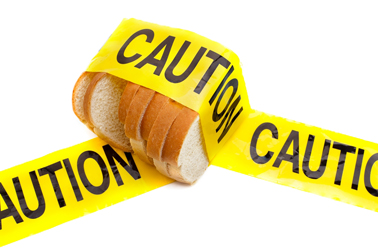 By TreeLiving We all know that eating healthy food, with lots of fruit and vegetables, is one of the secrets of wellbeing and longevity. But what constitutes healthy food seems to keep changing, with both new ‘super-foods’ and new scare stories regularly surfacing in the media. It can be confusing, but science and medicine have laid down clear and trustworthy guidelines about the health impact of some foods . Foods containing gluten are well documented as causing problems. Gluten is a protein found in wheat, rye and barley. In some people it causes an autoimmune reaction in the small intestine. Full-blown celiac disease, also known as sprue or gluten-sensitive enteropathy, affects more than 100 000 people in the US, and many more are allergic to wheat. Gluten is also implicated in blistering skin condition called dermatitis herpetiformis. There is no cure for gluten sensitivity, but these conditions can be managed with a gluten-free diet. Health conscious people may choose to cut down on gluten containing foods, in the interests of cutting down on starchy and refined or highly processed foods. Because gluten is found in a huge variety of foods (and even medications and cosmetics), an entirely gluten-free diet is difficult to achieve, so most adherents settle for a regiment that is as low in gluten as possible. Foods labelled ‘gluten free’ are permitted by law to contain a tiny amount – about 20 parts per million. That typically involves substituting other starches and carbohydrates. Corn and rice are top of the list, but alternatives include tapioca, sorghum and yams, as well as soy, other beans and nuts and nut flours. Various other flours, especially quinoa, but also including chickpea flour and buckwheat (which is not a wheat), are also used. Some people with wheat allergies (but not celiac sufferers) find they can tolerate spelt, a wheat flour that has lower gluten content. Opinion is divided on whether oats are suitable for celiac and allergy sufferers. Bread, which is an undeniable staple of western diets, may pose the biggest problems for people seeking to follow a gluten-free regime. Gluten is what gives dough its elasticity and adds lightness to the end product. To obtain an equivalent texture, additives such as eggs and corn starch may be added to the flours used for gluten-free bread. There’s good news for whiskey connoisseurs though – though whiskeys are made from gluten-containing grains, the gluten is denatured when the mash is distilled. Beer drinkers are not so fortunate, though there are a few gluten-free beers on the market. Anyone embarking on a gluten-free diet should also be aware that the substituted foods may be lower in nutrients and fiber than standard breads and allied products. However, a well rounded diet with lots of fruit and vegetables should compensate for this. A gluten-free diet can literally be a lifesaver for celiac sufferers, and could be health enhancers for anyone paying attention to eating healthy food.
By TreeLiving We all know that eating healthy food, with lots of fruit and vegetables, is one of the secrets of wellbeing and longevity. But what constitutes healthy food seems to keep changing, with both new ‘super-foods’ and new scare stories regularly surfacing in the media. It can be confusing, but science and medicine have laid down clear and trustworthy guidelines about the health impact of some foods . Foods containing gluten are well documented as causing problems. Gluten is a protein found in wheat, rye and barley. In some people it causes an autoimmune reaction in the small intestine. Full-blown celiac disease, also known as sprue or gluten-sensitive enteropathy, affects more than 100 000 people in the US, and many more are allergic to wheat. Gluten is also implicated in blistering skin condition called dermatitis herpetiformis. There is no cure for gluten sensitivity, but these conditions can be managed with a gluten-free diet. Health conscious people may choose to cut down on gluten containing foods, in the interests of cutting down on starchy and refined or highly processed foods. Because gluten is found in a huge variety of foods (and even medications and cosmetics), an entirely gluten-free diet is difficult to achieve, so most adherents settle for a regiment that is as low in gluten as possible. Foods labelled ‘gluten free’ are permitted by law to contain a tiny amount – about 20 parts per million. That typically involves substituting other starches and carbohydrates. Corn and rice are top of the list, but alternatives include tapioca, sorghum and yams, as well as soy, other beans and nuts and nut flours. Various other flours, especially quinoa, but also including chickpea flour and buckwheat (which is not a wheat), are also used. Some people with wheat allergies (but not celiac sufferers) find they can tolerate spelt, a wheat flour that has lower gluten content. Opinion is divided on whether oats are suitable for celiac and allergy sufferers. Bread, which is an undeniable staple of western diets, may pose the biggest problems for people seeking to follow a gluten-free regime. Gluten is what gives dough its elasticity and adds lightness to the end product. To obtain an equivalent texture, additives such as eggs and corn starch may be added to the flours used for gluten-free bread. There’s good news for whiskey connoisseurs though – though whiskeys are made from gluten-containing grains, the gluten is denatured when the mash is distilled. Beer drinkers are not so fortunate, though there are a few gluten-free beers on the market. Anyone embarking on a gluten-free diet should also be aware that the substituted foods may be lower in nutrients and fiber than standard breads and allied products. However, a well rounded diet with lots of fruit and vegetables should compensate for this. A gluten-free diet can literally be a lifesaver for celiac sufferers, and could be health enhancers for anyone paying attention to eating healthy food.
What is a Gluten-free Diet?

